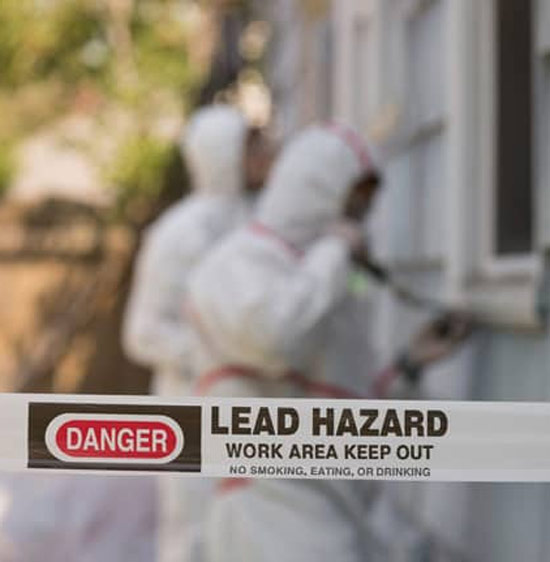Comprehensive Guide on Effective Lead Violation Removal Methods
In the realm of ecological security, addressing lead offenses demands a thorough and structured approach. This detailed guide starts by highlighting the crucial first steps of recognizing lead dangers through sophisticated assessment and testing approaches. The guide specifies on the significance of sticking to strict safety and security protocols throughout the removal process, consisting of the use of correct PPE and isolating impacted locations.
Identifying Lead Dangers
Identifying lead dangers is a crucial initial step in reducing the threats related to lead exposure. Lead, a poisonous metal, can be present in different ecological tools, including paint, soil, water, and dirt. It poses serious health and wellness threats, particularly to kids and expectant females, resulting in neurological damage and developing hold-ups. Exact identification of potential lead resources is vital for effective removal.
The first stage in recognizing lead hazards entails recognizing usual lead resources within the constructed setting. Frameworks developed before 1978 are especially vulnerable as a result of the prevalent use of lead-based paint during that duration. In addition, dirt contamination can happen from degrading exterior paint, industrial emissions, or historic use leaded gas.
Another significant resource is lead piping and pipes fixtures, which can leach lead right into alcohol consumption water. Durable goods such as playthings, porcelains, and imported products may additionally consist of dangerous lead levels. Notably, job-related settings and pastimes involving lead can track impurities right into homes.
Assessment and Screening
When attending to lead risks, reliable evaluation and testing are extremely important. This vital step ensures the recognition and quantification of lead visibility, thus guiding succeeding remediation initiatives. Initial analysis usually involves an aesthetic evaluation to recognize potential lead resources, such as weakening paint or infected dust. This is enhanced by more extensive testing methods to ascertain the degree of contamination.

Dust wipe tasting is another essential strategy, particularly in domestic setups. By accumulating examples from floorings, windowsills, and other surfaces, this method offers insights into prospective direct exposure threats. Furthermore, soil testing around building boundaries is vital to identify lead contamination that can posture hazards, especially to children.
Safe Removal Procedures
Upon completing comprehensive assessment and screening, applying secure elimination procedures is the next critical stage in resolving lead threats. This procedure guarantees that lead-contaminated materials are effectively and securely removed, reducing risk to both employees and citizens. The primary step entails separating the afflicted area making use of plastic sheet and proper securing methods to stop the spread of lead dirt.
Employees should wear proper personal safety devices (PPE), including respirators, handwear covers, and disposable coveralls, to minimize direct exposure. link Employing specialized devices and wet approaches, such as wet fining sand or utilizing HEPA-filtered vacuum cleaners, minimizes the dispersion of lead bits. It is essential to stay clear of dry fining sand or rough blowing up, as these techniques can create damaging lead dirt.
Waste disposal is an additional crucial component; all polluted products should be firmly nabbed and classified according to EPA and local guidelines. Additionally, complete cleaning of the work location with HEPA vacuum cleaners and wet cleaning ensures the removal of recurring lead fragments.
Post-Removal Verification

Confirmation of successful lead Read Full Article removal, known as post-removal verification, is crucial to make sure the safety and security and habitability of the remediated location. This assessment makes sure that all well-known resources of lead have been dealt with and that no visible signs of contamination remain.
Following the aesthetic examination, ecological sampling is carried out. This involves collecting dirt, dirt, and often water samples from the remediated area. Approved research laboratories examine these samples to measure lead degrees, guaranteeing they drop listed below the security thresholds established by governing bodies such as the Environmental Defense Company (EPA)
Additionally, air top quality screening may be performed to identify air-borne lead particles, specifically in instances where substantial lead-based paint removal or improvement has occurred. The outcomes of these tests give measurable data validating that the lead levels are within permitted limitations.
Inevitably, post-removal confirmation works as an essential checkpoint, verifying the effectiveness of the lead reduction efforts and securing the health of owners and visitors.
Safety Nets and Upkeep

A vital safety net includes making use of lead-safe certified specialists for any remodelling, fixing, or painting activities. These specialists are learnt methods that decrease lead dust and debris. In addition, keeping painted surface areas to stay clear of chipping or peeling is crucial, as deteriorating paint can release lead bits right into the environment.
Educational initiatives targeting homeowner and renters relating to the threats of lead and the relevance of reporting any potential risks can additionally boost preventative initiatives. Regular cleaning using HEPA vacuums and wet mopping techniques can dramatically lower lead dirt buildup.
Conclusion
In summary, effective lead violation removal necessitates a meticulous technique including complete evaluation, accurate screening, and strict removal procedures. Ensuring safety and security through correct isolation and individual safety devices continues to be paramount. Post-removal verification through environmental sampling and air quality screening confirms conformity with well established security standards. Furthermore, ongoing examinations and upkeep are necessary to alleviate future lead risks, thus securing public health and wellness and guaranteeing continual conformity with regulatory requirements.